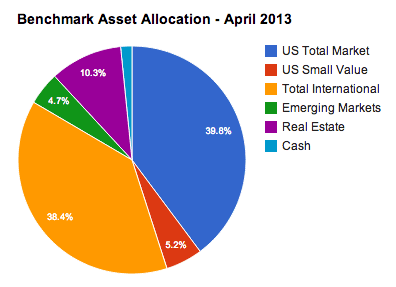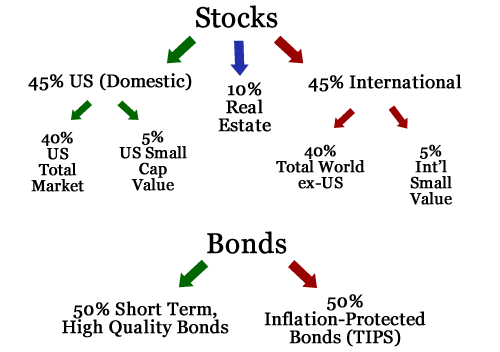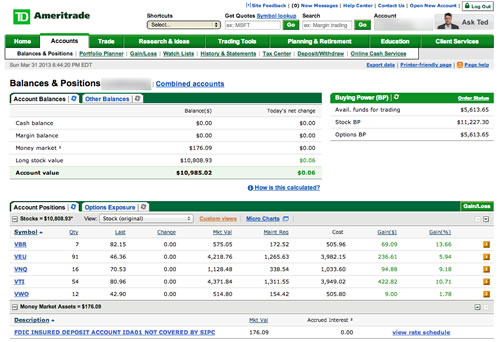Here’s the April 2013 update for my benchmark portfolio, the first of three portfolios started on November 1st, 2012 as part of my Beat the Market Experiment:
- $10,000 Passive Benchmark Portfolio that would serve as both a performance benchmark and an real-world, low-cost portfolio that would be easy to replicate and maintain for DIY investors.
- $10,000 Beat-the-Benchmark Speculative Portfolio that would simply represent the attempts of an “average guy” who is not a financial professional and gets his news from mainstream sources to get the best overall returns possible.
- $10,000 P2P Consumer Lending Speculative Portfolio – Split evenly between LendingClub and Prosper, this portfolio is designed to test out the alternative investment class of person-to-person loans. The goal is again to beat the benchmark by setting a target return of 8-10% net of defaults.
$10,000 Benchmark Portfolio as of April 1, 2013. My account is held at TD Ameritrade due to their 100 commission-free ETF program that includes free trades on the best low-cost, index ETFs from Vanguard and iShares. I funded it with $10,000 and bought all the ETFs required to be fully invested on 11/1/12. All trades were commission-free.
Here’s a screenshot from my account showing exact holdings and their market value on 3/31/13. With the current bull market, the benchmark portfolio gained nearly 10% in just 5 months.
Here’s the asset allocation pie chart, tracked with a simple Google Docs spreadsheet:

No new trades over the past month as the allocations are still close to targets. Received about $40 in dividends. Here is the target asset allocation again:

Due to simplicity and small portfolio size, for now I am going with 100% stocks and no bonds. This is meant to be appropriate for young investors, who should try to get a long horizon for stocks and can add more bonds later on. According to popular glide paths, a rule-of-thumb is having your age minus 20% in bonds. Here are the ETF components that represent each asset class:
US Total Market – Vanguard Total Stock Market ETF (VTI)
US Small Value – Vanguard Small Cap Value ETF (VBR)
International Total Market – Vanguard FTSE All-World ex-US ETF (VEU)
International Small Value – Vanguard FTSE Emerging Markets ETF (VWO)
Real Estate – Vanguard REIT Index ETF (VNQ)
I hope that VXUS is added soon to their commission-free list, as it is a more complete ETF than VEU.
Total value of stocks: $10,808.93
Cash balance: $176.09
Total portfolio value (3/2/13): $10,985.02
2013 YTD return: 6.1% (based on $10,350.65 value on 1/1/13)
Total return since inception (11/1/12): $985.02, or 9.9%

 The Best Credit Card Bonus Offers – 2025
The Best Credit Card Bonus Offers – 2025 Big List of Free Stocks from Brokerage Apps
Big List of Free Stocks from Brokerage Apps Best Interest Rates on Cash - 2025
Best Interest Rates on Cash - 2025 Free Credit Scores x 3 + Free Credit Monitoring
Free Credit Scores x 3 + Free Credit Monitoring Best No Fee 0% APR Balance Transfer Offers
Best No Fee 0% APR Balance Transfer Offers Little-Known Cellular Data Plans That Can Save Big Money
Little-Known Cellular Data Plans That Can Save Big Money How To Haggle Your Cable or Direct TV Bill
How To Haggle Your Cable or Direct TV Bill Big List of Free Consumer Data Reports (Credit, Rent, Work)
Big List of Free Consumer Data Reports (Credit, Rent, Work)
Hi Johnathan,
Thank you for the update.
I probably have missed something. Is it a reason you haven’t reinvest the dividends or include them as yield of return?
@Nicole – I prefer not to do automatic dividend reinvestment (even though it is available at TD Ameritrade) in a taxable account because of the many small tax lots that get created, and because I can instead use the accumulated cash to rebalance between asset classes as needed annually. I don’t think it makes a huge difference either way, I think it’s fine to reinvest if you wish. Hope that made sense, thanks for reading!
What a great point, Jonathan. Just went to Vanguard and changed my election on all my taxable investments. Thanks!
@HouseofG – No problem, I do the same thing at Vanguard, less hassle at tax time although with mutual funds it’s not that bad if you let Vanguard track everything and use average share price accounting. Just gotta remember to deploy that cash balance before it gets too big.